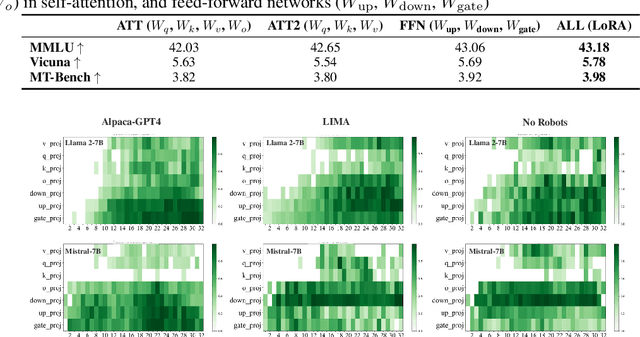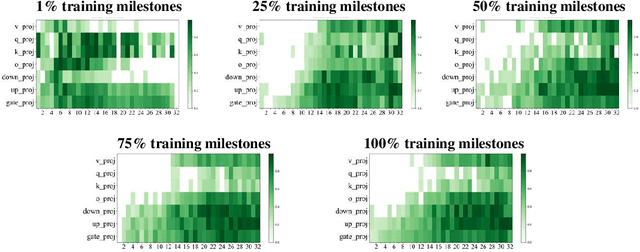Yujie Feng
GeoEdit: Geometric Knowledge Editing for Large Language Models
Feb 27, 2025Abstract:Regular updates are essential for maintaining up-to-date knowledge in large language models (LLMs). Consequently, various model editing methods have been developed to update specific knowledge within LLMs. However, training-based approaches often struggle to effectively incorporate new knowledge while preserving unrelated general knowledge. To address this challenge, we propose a novel framework called Geometric Knowledge Editing (GeoEdit). GeoEdit utilizes the geometric relationships of parameter updates from fine-tuning to differentiate between neurons associated with new knowledge updates and those related to general knowledge perturbations. By employing a direction-aware knowledge identification method, we avoid updating neurons with directions approximately orthogonal to existing knowledge, thus preserving the model's generalization ability. For the remaining neurons, we integrate both old and new knowledge for aligned directions and apply a "forget-then-learn" editing strategy for opposite directions. Additionally, we introduce an importance-guided task vector fusion technique that filters out redundant information and provides adaptive neuron-level weighting, further enhancing model editing performance. Extensive experiments on two publicly available datasets demonstrate the superiority of GeoEdit over existing state-of-the-art methods.
Recurrent Knowledge Identification and Fusion for Language Model Continual Learning
Feb 22, 2025Abstract:Continual learning (CL) is crucial for deploying large language models (LLMs) in dynamic real-world environments without costly retraining. While recent model ensemble and model merging methods guided by parameter importance have gained popularity, they often struggle to balance knowledge transfer and forgetting, mainly due to the reliance on static importance estimates during sequential training. In this paper, we present Recurrent-KIF, a novel CL framework for Recurrent Knowledge Identification and Fusion, which enables dynamic estimation of parameter importance distributions to enhance knowledge transfer. Inspired by human continual learning, Recurrent-KIF employs an inner loop that rapidly adapts to new tasks while identifying important parameters, coupled with an outer loop that globally manages the fusion of new and historical knowledge through redundant knowledge pruning and key knowledge merging. These inner-outer loops iteratively perform multiple rounds of fusion, allowing Recurrent-KIF to leverage intermediate training information and adaptively adjust fusion strategies based on evolving importance distributions. Extensive experiments on two CL benchmarks with various model sizes (from 770M to 13B) demonstrate that Recurrent-KIF effectively mitigates catastrophic forgetting and enhances knowledge transfer.
A Progressive Image Restoration Network for High-order Degradation Imaging in Remote Sensing
Dec 10, 2024



Abstract:Recently, deep learning methods have gained remarkable achievements in the field of image restoration for remote sensing (RS). However, most existing RS image restoration methods focus mainly on conventional first-order degradation models, which may not effectively capture the imaging mechanisms of remote sensing images. Furthermore, many RS image restoration approaches that use deep learning are often criticized for their lacks of architecture transparency and model interpretability. To address these problems, we propose a novel progressive restoration network for high-order degradation imaging (HDI-PRNet), to progressively restore different image degradation. HDI-PRNet is developed based on the theoretical framework of degradation imaging, offering the benefit of mathematical interpretability within the unfolding network. The framework is composed of three main components: a module for image denoising that relies on proximal mapping prior learning, a module for image deblurring that integrates Neumann series expansion with dual-domain degradation learning, and a module for super-resolution. Extensive experiments demonstrate that our method achieves superior performance on both synthetic and real remote sensing images.
Understanding Layer Significance in LLM Alignment
Oct 23, 2024



Abstract:Aligning large language models (LLMs) through fine-tuning is essential for tailoring them to specific applications. Therefore, understanding what LLMs learn during the alignment process is crucial. Recent studies suggest that alignment primarily adjusts a model's presentation style rather than its foundational knowledge, indicating that only certain components of the model are significantly impacted. To delve deeper into LLM alignment, we propose to identify which layers within LLMs are most critical to the alignment process, thereby uncovering how alignment influences model behavior at a granular level. We propose a novel approach to identify the important layers for LLM alignment (ILA). It involves learning a binary mask for each incremental weight matrix in the LoRA algorithm, indicating the significance of each layer. ILA consistently identifies important layers across various alignment datasets, with nearly 90% overlap even with substantial dataset differences, highlighting fundamental patterns in LLM alignment. Experimental results indicate that freezing non-essential layers improves overall model performance, while selectively tuning the most critical layers significantly enhances fine-tuning efficiency with minimal performance loss.
Parenting: Optimizing Knowledge Selection of Retrieval-Augmented Language Models with Parameter Decoupling and Tailored Tuning
Oct 14, 2024



Abstract:Retrieval-Augmented Generation (RAG) offers an effective solution to the issues faced by Large Language Models (LLMs) in hallucination generation and knowledge obsolescence by incorporating externally retrieved knowledge. However, due to potential conflicts between internal and external knowledge, as well as retrieval noise, LLMs often struggle to effectively integrate external evidence, leading to a decline in performance. Although existing methods attempt to tackle these challenges, they often struggle to strike a balance between model adherence and robustness, resulting in significant learning variance. Inspired by human cognitive processes, we propose Parenting, a novel framework that decouples adherence and robustness within the parameter space of LLMs. Specifically, Parenting utilizes a key parameter mining method based on forward activation gain to identify and isolate the crucial parameter units that are strongly linked to adherence and robustness. Then, Parenting employs a type-guided tailored tuning strategy, applying specific and appropriate fine-tuning methods to parameter units representing different capabilities, aiming to achieve a balanced enhancement of adherence and robustness. Extensive experiments on various datasets and models validate the effectiveness and generalizability of our methods.
Diversity-grounded Channel Prototypical Learning for Out-of-Distribution Intent Detection
Sep 17, 2024Abstract:In the realm of task-oriented dialogue systems, a robust intent detection mechanism must effectively handle malformed utterances encountered in real-world scenarios. This study presents a novel fine-tuning framework for large language models (LLMs) aimed at enhancing in-distribution (ID) intent classification and out-of-distribution (OOD) intent detection, which utilizes semantic matching with prototypes derived from ID class names. By harnessing the highly distinguishable representations of LLMs, we construct semantic prototypes for each ID class using a diversity-grounded prompt tuning approach. We rigorously test our framework in a challenging OOD context, where ID and OOD classes are semantically close yet distinct, referred to as \emph{near} OOD detection. For a thorough assessment, we benchmark our method against the prevalent fine-tuning approaches. The experimental findings reveal that our method demonstrates superior performance in both few-shot ID intent classification and near-OOD intent detection tasks.
Continual Dialogue State Tracking via Reason-of-Select Distillation
Aug 19, 2024



Abstract:An ideal dialogue system requires continuous skill acquisition and adaptation to new tasks while retaining prior knowledge. Dialogue State Tracking (DST), vital in these systems, often involves learning new services and confronting catastrophic forgetting, along with a critical capability loss termed the "Value Selection Quandary." To address these challenges, we introduce the Reason-of-Select (RoS) distillation method by enhancing smaller models with a novel 'meta-reasoning' capability. Meta-reasoning employs an enhanced multi-domain perspective, combining fragments of meta-knowledge from domain-specific dialogues during continual learning. This transcends traditional single-perspective reasoning. The domain bootstrapping process enhances the model's ability to dissect intricate dialogues from multiple possible values. Its domain-agnostic property aligns data distribution across different domains, effectively mitigating forgetting. Additionally, two novel improvements, "multi-value resolution" strategy and Semantic Contrastive Reasoning Selection method, significantly enhance RoS by generating DST-specific selection chains and mitigating hallucinations in teachers' reasoning, ensuring effective and reliable knowledge transfer. Extensive experiments validate the exceptional performance and robust generalization capabilities of our method. The source code is provided for reproducibility.
TaSL: Continual Dialog State Tracking via Task Skill Localization and Consolidation
Aug 19, 2024Abstract:A practical dialogue system requires the capacity for ongoing skill acquisition and adaptability to new tasks while preserving prior knowledge. However, current methods for Continual Dialogue State Tracking (DST), a crucial function of dialogue systems, struggle with the catastrophic forgetting issue and knowledge transfer between tasks. We present TaSL, a novel framework for task skill localization and consolidation that enables effective knowledge transfer without relying on memory replay. TaSL uses a novel group-wise technique to pinpoint task-specific and task-shared areas. Additionally, a fine-grained skill consolidation strategy protects task-specific knowledge from being forgotten while updating shared knowledge for bi-directional knowledge transfer. As a result, TaSL strikes a balance between preserving previous knowledge and excelling at new tasks. Comprehensive experiments on various backbones highlight the significant performance improvements of TaSL over existing state-of-the-art methods. The source code is provided for reproducibility.
TaSL: Task Skill Localization and Consolidation for Language Model Continual Learning
Aug 09, 2024Abstract:Language model continual learning (CL) has recently garnered significant interest due to its potential to adapt large language models (LLMs) to dynamic real-world environments without re-training. A key challenge in this field is catastrophic forgetting, where models lose previously acquired knowledge when learning new tasks. Existing methods commonly employ multiple parameter-efficient fine-tuning (PEFT) blocks to acquire task-specific knowledge for each task, but these approaches lack efficiency and overlook the potential for knowledge transfer through task interaction. In this paper, we present a novel CL framework for language models called Task Skill Localization and Consolidation (TaSL), which enhances knowledge transfer without relying on memory replay. TaSL first divides the model into `skill units' based on parameter dependencies, enabling more granular control. It then employs a novel group-wise skill localization technique to identify the importance distribution of skill units for a new task. By comparing this importance distribution with those from previous tasks, we implement a fine-grained skill consolidation strategy that retains task-specific knowledge, thereby preventing forgetting, and updates task-shared knowledge, which facilitates bi-directional knowledge transfer. As a result, TaSL achieves a superior balance between retaining previous knowledge and excelling in new tasks. TaSL also shows strong generalizability, suitable for general models and customizable for PEFT methods like LoRA. Additionally, it demonstrates notable extensibility, allowing integration with memory replay to further enhance performance. Extensive experiments on two CL benchmarks, with varying model sizes (from 220M to 7B), demonstrate the effectiveness of TaSL and its variants across different settings.
Towards LLM-driven Dialogue State Tracking
Oct 23, 2023Abstract:Dialogue State Tracking (DST) is of paramount importance in ensuring accurate tracking of user goals and system actions within task-oriented dialogue systems. The emergence of large language models (LLMs) such as GPT3 and ChatGPT has sparked considerable interest in assessing their efficacy across diverse applications. In this study, we conduct an initial examination of ChatGPT's capabilities in DST. Our evaluation uncovers the exceptional performance of ChatGPT in this task, offering valuable insights to researchers regarding its capabilities and providing useful directions for designing and enhancing dialogue systems. Despite its impressive performance, ChatGPT has significant limitations including its closed-source nature, request restrictions, raising data privacy concerns, and lacking local deployment capabilities. To address these concerns, we present LDST, an LLM-driven DST framework based on smaller, open-source foundation models. By utilizing a novel domain-slot instruction tuning method, LDST achieves performance on par with ChatGPT. Comprehensive evaluations across three distinct experimental settings, we find that LDST exhibits remarkable performance improvements in both zero-shot and few-shot setting compared to previous SOTA methods. The source code is provided for reproducibility.
 Add to Chrome
Add to Chrome Add to Firefox
Add to Firefox Add to Edge
Add to Edge